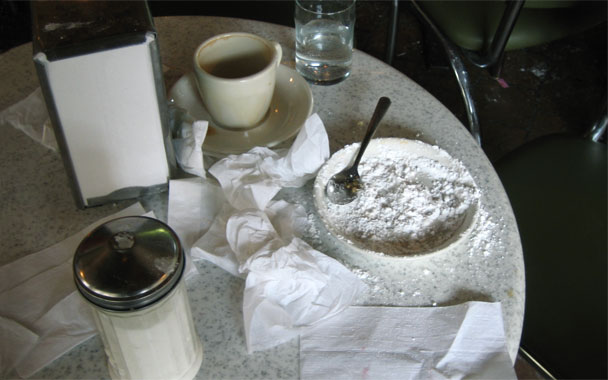An hour into my first visit to the Café du Monde, I sat thoroughly pleased by the warm night, warm coffee, warm beignets. This is the place I’ve been waiting to come to ever since seeing, as a child, a bright orange tin of their coffee in my mother’s pantry and imagining its lazy Louisiana evenings.
I looked around and saw that many tables were occupied by obvious tourists, probably also brought here by a preconception, some personal equivalent of my mother’s coffee tin. I was not surprised. The place has all the markings of a tourist trap—souvenirs for sale, a ramshackle shabbiness, a stuck-in-amber spirit that serves to both attract visitors and forbid the place from changing. (It added soft drinks to its menu in 1988, 126 years after it opened. No one orders them.) It seems like the sort of destination that is so closely associated with the stereotypical idea of a place that one would never find a local, like how Times Square is the best place to avoid running into New Yorkers.
And yet while talking to New Orleanians, I found that the Café du Monde is still very much a landmark—an experience—that they claim for themselves, that they call home.
When I started asking around, many wanted to tell me stories of their first visit to the Café after Katrina. Brooks Hamaker made a point of going there the day it reopened, “Just to be able to pretend that life was going to return to normal.” Sara Roahen, author of “Gumbo Tales,” a memoir of food and consequently of this city, told me about being waited on by a server with an enormous bust and a pencil-thin mustache, which actually may qualify as normal here. When you talk to New Orleanians, you hear lots of stories of post-storm firsts, but their urge to talk about the Café in this way speaks of its centrality in their idea of their home.
As this is a city known for its love affair with its food, the first thing is what’s on the menu. John Currence, the New Orleans–bred chef of the City Grocery in Oxford, Mississippi conceded, “Sure, the Café du Monde is a tourist trap.” But, he insists, “Their beignets are as iconic New Orleans as it gets. They’re imperative.”
For Cynthia Joyce, they helped to define her cultural relationship with this place. Moving here six years ago, she struggled at first to find her Acadian heritage in what is French America’s capital. Then she went to the Café du Monde. “The beignets were exactly what my aunt would make,” she recalls. For her, this flavor helped to bridge the foreign and familiar; it made her feel at home.
Jonathan Leit used to visit New Orleans often on business, taking away his beignets to enjoy while strolling along the Mississippi River. But since moving here a year ago, experiencing the transition from visitor to resident, he now feels a strong urge to eat them at the Café, “reveling in my white-coated face with others,” he says. For him, the experience is communal and welcoming. “Economic necessity aside,” he explains, “this city actively seeks to bestow its hedonism on visitors, and sincerely enjoys—takes pride in—sharing tourists’ indulgences in the culture.” And, as it turns out, the Café has always been a place of welcome outsiders. Mr. Hamaker joked to me, “The Café du Monde opened during the Civil War, so it has been serving Yankee tourists, beginning with an occupying army, for as long as it has been open.”
Listening to these stories, then, it occurred to me that perhaps my urge to divide the locals and the tourists was misguided. In Gumbo Tales, Ms. Roahen writes that New Orleans is fundamentally infused with a powerful sense of nostalgia. Nostalgia can make even locals into tourists, looking to find the past of a place that they inhabit ineffably in the present. In that sense, an out-of-town visitor and an out-of-time resident may share these coffees and these beignets as equals in foreignness, which is why the Café du Monde can seem like a caricature and yet still very real.
As Ms. Joyce discovered eventually, in New Orleans, “Even the authentic experiences can seem indistinguishable from the stereotype. At first it felt like the whole city was miming my expectation of it, until I realized that’s really the way it is.” She told me more stories from there, some outrageous and some commonplace. “The Café du Monde,” she said finally, “is a genuine favorite place.”


